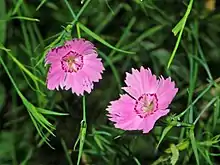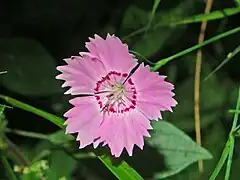Dianthus seguieri
Dianthus seguieri, common name Seguier's pink, is a herbaceous perennial plant[2] of the genus Dianthus of the family Caryophyllaceae.
| Dianthus seguieri | |
|---|---|
 | |
| Flowers of Dianthus seguieri | |
| Scientific classification | |
| Kingdom: | Plantae |
| Clade: | Tracheophytes |
| Clade: | Angiosperms |
| Clade: | Eudicots |
| Order: | Caryophyllales |
| Family: | Caryophyllaceae |
| Genus: | Dianthus |
| Species: | D. seguieri |
| Binomial name | |
| Dianthus seguieri Vill. | |
| Synonyms | |
| |

Etymology
The genus name Dianthus derives from the Greek words for divine ("dios") and flower ("anthos"), while the species name seguieri honors the French botanist Jean-François Séguier (1733 – 1784).[1]
Description
Dianthus seguieri is a hemicryptophyte scapose plant[1][2] reaching 25–60 centimetres (9.8–23.6 in) in height.[1][3] This carnation has green lanceolate leaflets and pink flowers, with purple markings in the centre.[2][3] The flowering period extends from June through September.[1][2] The fruits are capsules with several brown seeds.[1]
Distribution
This species is present in southern and central Europe, mainly in Spain, France, Germany, Italy, Russia , and Switzerland.[2][3]
Habitat
Dianthus seguieri grows in dry meadows at an altitude of 100–1,000 metres (330–3,280 ft) above sea level.[1][2][3]
Gallery
 Figure from Deutschlands Flora in Abbildungen, 1796
Figure from Deutschlands Flora in Abbildungen, 1796 Flower of Dianthus seguieri
Flower of Dianthus seguieri Flower of Dianthus seguieri subsp. glaber
Flower of Dianthus seguieri subsp. glaber.JPG.webp) Leaves of Dianthus seguieri
Leaves of Dianthus seguieri
References
- Acta Plantarum
- Luirig Altervista
- Pignatti S. - Flora d'Italia – Edagricole – 1982. Vol. I, pag. 266